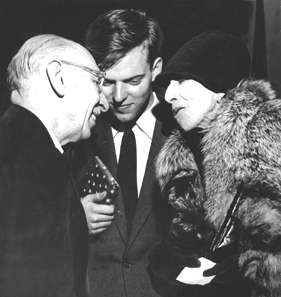Movements for Piano and Orchestra

Movements for Piano and Orchestra is a composition by Igor Stravinsky, written during the his serial period,[1] consisting of five short movements altogether lasting around nine minutes.
The piece is notable in that it shows Stravinsky's complete dedication to the serial idiom which was notably more tentative in previous serial based compositions and shows the distinct influence of Anton Webern on Stravinsky's own serial language.[2]
Composition
Stravinsky composed the Movements on commission by a Swiss industrialist for his pianist wife Margrit Weber, for the sum of $15,000. Mrs. Weber premiered the work at a Stravinsky Festival in New York’s Town Hall on January 10, 1960 with the composer himself conducting. Herr Weber had asked for a work of between 15 and 20 minutes but instead Stravinsky fulfilled the commission with a more refined and compressed piece lasting around half the length of the commission.[3]
Analysis
Stravinsky breaks the orchestra down into smaller chamber-like sections with the piano acting as a pivot between the smaller contrasting sections of the orchestra creating subtle and gestural textures favored by Webern in pieces such as his Concerto for Nine Instruments (op. 24) and the Variations for Orchestra (op. 30) the latter of which Stravinsky admired greatly.[3]
Due to the highly constructed nature of the twelve tone idiom employed, all thematic material is drawn from a single tone row which is given by the solo piano in a very nonlinear gesture at the very opening of the work: E♭ F♭ B♭ A♭ A♮ D C B♮ C♯ F♯ G and F♮.[4] The row is really only presented in its complete form a couple of times; it is far more often broken up into smaller groups and manipulated into slightly varied orderings. The technique of Klangfarbenmelodie can thus clearly be heard particularly in the opening of the piece that's gestural phrase mimics that of Webern's op.24 [5]
Stravinsky himself described the harmonic structure of Movements as "anti-tonal".[6] Traditional references to triadic harmonic structures are eliminated in favor of an almost total linear based idiom with conventional ostinati and harmonic considerations replaced with an atonal and highly contrapuntal texture characterized by gestures, inner unity and a strict adherence to serial forms far more pervasive than in previous serial compositions by Stravinsky.
Orchestration: 2 flutes (2nd = piccolo), oboe, English horn, clarinet, bass clarinet, bassoon, 2 trumpets, 3 trombones, harp, celesta, strings, and solo piano.
References
- ↑ Gardner, Howard (1993). Creating Minds. Basic Books – via Questia (subscription required) . p. 223.
- ↑ http://www.laphil.com/philpedia/music/movements-for-piano-and-orchestra-igor-stravinsky
- 1 2 Rust, Douglas (1994). "Stravinsky's Twelve-Tone Loom: Precomposition and Composition in Movements". Music Theory Spectrum. 16 (1 (Spring)): 62–76. doi:10.1525/mts.1994.16.1.02a00030.
- ↑ http://www.allmusic.com/composition/movements-5-for-piano-amp-orchestra-mc0002361575
- ↑ Brian Bice, "Klangfarbenmelodie", New Music Forum website (archive from 3 December 2013, accessed 6 July 2014).
- ↑ Stravinsky, Igor; Craft, Robert (2002 (first edition, 1960)). Memories and Commentaries. London: Faber & Faber. ISBN 0-571-21242-5. Check date values in:
|date=(help)
Further reading
- Babbitt, Milton. 1986. "Order, Symmetry, and Centricity in Late Stravinsky". In Confronting Stravinsky: Man, Musician, and Modernist, edited by Jann Pasler, 247–61. Berkeley, Los Angeles and London: University of California Press. ISBN 0-520-05403-2.
- Babbitt, Milton. 1987. "Stravinsky's Verticals and Schoenberg's Diagonals: A Twist of Fate". In Stravinsky Retrospectives, edited by Ethan Haimo and Paul Johnson, 15–35. Lincoln and London: University of Nebraska Press. ISBN 0-8032-7301-0.
- Cone, Edward T. 1962. "The Uses of Convention: Stravinsky and His Models". The Musical Quarterly 48, no. 3, Special Issue for Igor Stravinsky on His 80th Anniversary (July): 287–99.
- Keller, Hans. 1961. No Bridge to Nowhere: An Introduction to Stravinsky's Movements and Schoenberg's Violin Concerto . The Musical Times 102, no. 1417 (March): 156–58.
- Locanto, Massimiliano. 2009. "'Composing with Intervals': Intervallic Syntax and Serial Technique in Late Stravinsky", translated by Chadwick Jenkins. Music Analysis 28, nos. 2–3 (July–October): 221–66.
- Straus, Joseph N. 2001. Stravinsky's Late Music. Cambridge Studies in Music and Analysis. Cambridge and New York: Cambridge University Press. ISBN 978-0-521-60288-4.
- White, Eric Walter. 1979. Stravinsky: The Composer and His Works, second edition. Berkeley and Los Angeles: The University of California Press. ISBN 0-520-03985-8.